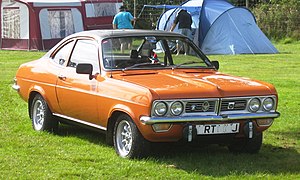Vauxhall Firenza
The Vauxhall Firenza was manufactured by Vauxhall from 1970 to 1975. It was derived from the Vauxhall Viva HC, but had a coupé body with two doors that was clearly different from the sedan.
The Firenza was initially available with a 1159 cm³ four-cylinder OHV in-line engine and a 1598 cm³ four-cylinder OHC in-line engine. Both machines were later drilled out to 1256 cm³ and 1798 cm³ respectively. In all models, the engine was installed at the front and drove the rear axle. The front suspension consisted of double wishbones and coil springs, the rear drive axle had trailing arms and coil springs as well.
Firenza Droopsnoot
In 1973, Vauxhall decided that their rather bland range of models needed a refresh and developed a version of the Firenza, officially called "HP" (High Performance), but popularly known as the "Droopsnoot" (droopsnoot) because of its dramatic aerodynamic nose . The muzzle was made of GRP and contained Cibié headlights, which were protected by cladding made of unbreakable glass. The front design of the car was somewhat reminiscent of the Renault Alpine A310 .
At the same time, the normal flat-nose Firenza model was renamed the Vauxhall Magnum Coupe and the name Firenza was used exclusively for the HP version. This car was an exciting approach to styling for Vauxhall, and opinions were certainly varied. The engine was a 2.3-liter variant of the 4-cylinder OHC in-line engine, which was very high-torque and developed 131 bhp (96 kW). Many parts from Blydenstein Racing were used: it had Stromberg 175 carburetors, a high camshaft and free-flow exhaust manifold. The car was designed by an American designer, Wayne Cherry, and had a very low drag coefficient for the time. The chassis was revised and lowered, the brakes revised and a 5-speed ZF transmission installed. All of this resulted in a much stronger (albeit louder) drive than the standard model. Another unusual special feature of the vehicle was its aluminum wheels from AVON, which were designed to hold the tire safely on the rim in the event of a flat tire. The Firenza was the first production vehicle to use this technology. All series Firenza were painted in the same color - "Silver Starfire" - and had a mostly black interior with silver-gray, fabric-covered seats. A somewhat dubious equipment detail was the handle for the passenger, which was attached to the dashboard instead of the glove compartment.
The car was a design highlight for Vauxhall, but also a sales flop. It was presented with a lot of advertising at a special race in Thruxton , Hampshire and driven by well-known drivers such as Gerry Marshall and Barry Williams. Barry Williams also won the race. Nonetheless, given the raging oil crisis, it became difficult to sell cars with such unrestrained gas mileage, even if the aerodynamic snout already significantly reduced gas mileage because it took around 30 bhp less to reach top speed. This fact, combined with some difficulties with the production line, kept production and sales figures low. Presumably only 204 pieces were built, far fewer than the 30,000 targeted copies. These very low numbers were of course a disaster for Vauxhall, but that resulted in this vehicle becoming a cherished classic, which ensures its survival better than that of some standard production vehicles that were made at the same time and are now harder to find. A well-known owner of a Firenza HP was the British footballer Luther Blissett .
In the 1970s, the Firenza was also very successful in racing for near-series vehicles, especially in the "Old Nail" and "Baby Bertha" versions, which Gerry Marshall drove with great success.
Despite the low production figures, the aerodynamic qualities and styling of the "Droopsnoot" were also found in other new Vauxhall models of the 1970s: the Chevette , the Cavalier and the Carlton . The Firenza can be seen as a styling prototype for these vehicles. Its influence can already be seen in the fact that Ford chose a similar appearance for its Escort Mark II RS2000 and for the Sierra from 1982. These vehicles, in turn, were copied many times by other manufacturers in the 1980s. The Firenza HP looks a lot less out of date than many of its contemporaries.
Performance
- Top speed: 193 km / h
- Acceleration 0-100 km / h: 8.1 seconds
- Petrol consumption: 11.3 l / 100 km
Production in South Africa
In South Africa the Firenza was manufactured by General Motors South Africa as the Chevrolet Firenza . As a special model, the Chevrolet Firenza CanAm (also called Little Chev ) was equipped with the Camaro's 5-liter V8 engine and 100 copies were built for homologation purposes. The vehicles, which were delivered exclusively in white with a black bonnet, accelerated to a top speed of around 230 km / h with 290 hp.
Models of competition
- Ford Capri
- Ford Escort RS2000
- Triumph Dolomite Sprint
- Rover SD1
- Hillman Avenger Tiger
Web links
Individual evidence
- ↑ Chevrolet Firenza Can Am , in CarTorque of December 11, 2005.
- ↑ Chev Firenza CanAm , article on African Muscle Cars .


